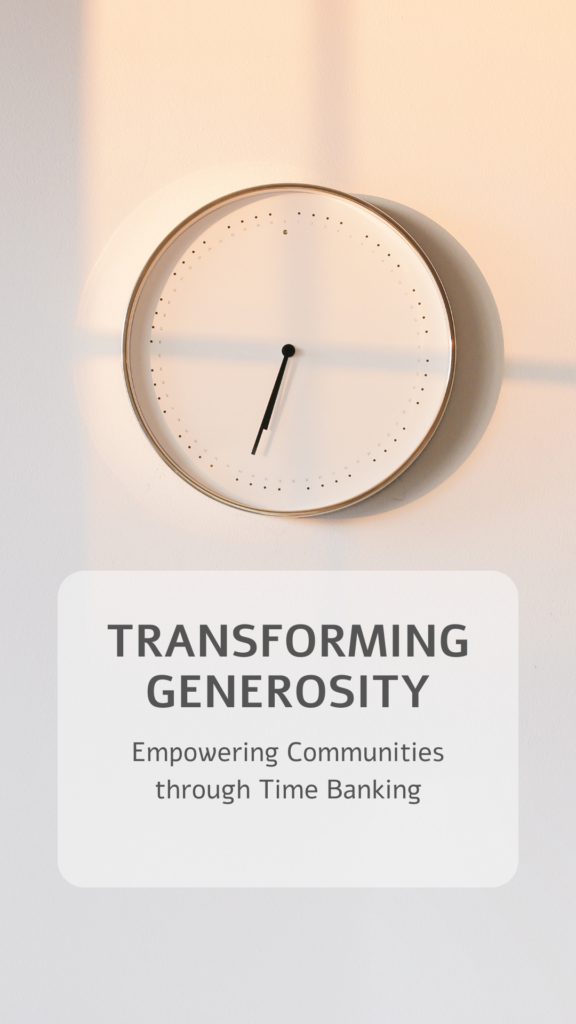
“The Evolution of Giving: An Exploration of Time Banking as a
Community Development Instrument”
By
Sara Singh
University of South Carolina
Introduction
If you’ve ever done someone a favor, whether it’s running an errand, preparing a meal, or tending to their garden, with the genuine expectation that this kindness would be reciprocated, you’ve informally engaged with an alternative form of currency: trust. Think of money as tangible trust. The value of a dollar is derived from the collective faith that everyone places in the issuer’s commitment to honor the printed value on that currency. Trust in the integrity of the monetary system is its cornerstone.
Reciprocal actions are essential within families and friendships as they reinforce social bonds, promoting altruism and investments of time and energy. However, in larger networks, sustaining these exchanges becomes a logistical challenge. Without regular contact or physical proximity, ensuring that your favor will be returned is difficult. Assisting others with no guarantee of receiving something in return comes at an opportunity cost, which is why many people are not consistently motivated to volunteer their time to strangers. But when a system of incentives is introduced and recognized by a third party capable of tracking service transactions, the full potential of reciprocity can be harnessed in large networks, generating social capital and empowering individuals.
According to Seyfang, “a time-based currency is an alternative currency or exchange system where the unit of account or value is the person-hour or some other time unit. Some time-based currencies value everyone’s contributions equally: one hour equals one service credit. In these systems, one person volunteers an hour of work for another person, earning one service credit which they can later redeem for an hour of service from another volunteer. Time banking aims to strengthen the ‘core economy’ of families and communities by valuing and rewarding the work carried out within it” (Seyfang, 2004). A time bank operates differently from traditional volunteer organizations because it encourages individuals to receive as much as they give.
Time banking allows those without financial means to access the same goods and services by earning the trust of others within their community. It’s a social innovation that rewards both knowledge-sharing and physical work with social capital and personal fulfillment, thereby nurturing networks of reciprocity. Time banks bring people and local organizations together to provide assistance, making use of previously untapped resources and skills, and recognizing the value of work that often goes unrewarded. They also appreciate individuals who are typically marginalized within the mainstream economy (Han, Shih, Bellotti, Carroll, 2015).
According to “Building Community with Time Dollars,” a social policy publication from The Annie E. Casey Foundation, “Time Dollars are a form of currency earned by helping others and spent by receiving help from others. They serve as a medium of exchange designed to reward altruism by acknowledging, validating, and compensating contributions that strengthen and rebuild the ‘core economy’ of home, neighborhood, and community. The time dollar approach is built on the belief that every member of a community is a valuable resource, not just a ‘giver’ or a ‘receiver,’ and that each community can pool these resources for its own social and economic enrichment” (The Annie E. Casey Foundation, 2004).
Time banks create ‘weak ties’ within communities by establishing social connections among disconnected groups, rather than simply reinforcing existing relationships which may exclude ‘outsiders’ (Seyfang, 2004). Time banks can also bridge generational gaps (James, 2005). Edgar Cahn once articulated, “The vision of the time bank system’s creators was the development of a society that allocates its time more strategically, for goals that go beyond the making and sacrificing of money.” He expressed in “No More Throw-Away People” his desire to promote “decency, caring, and a passion for justice” with this new form of currency (Time Banks USA, n.d.). While this concept may be critiqued for its idealism, its goal is to evolve a practical and intrinsic human tradition: giving.
In our view, the website timebanks.org is a well-informed source of information on the concept and its practical applications. Currently, the most common model of time banking involves neighbors assisting one another to support the most vulnerable and to foster a strong sense of community. However, individuals and organizations are increasingly tailoring the use of time banking to achieve specific objectives. The timebanks.org website presents a list of goals, including restoring trust within the community, enhancing educational outcomes, reducing the number of students in the school-to-prison pipeline, increasing savings for public housing residents, providing in-house support for hospital patients, supporting art and music projects, and offering counseling services for seniors (Time Banks USA, n.d.).